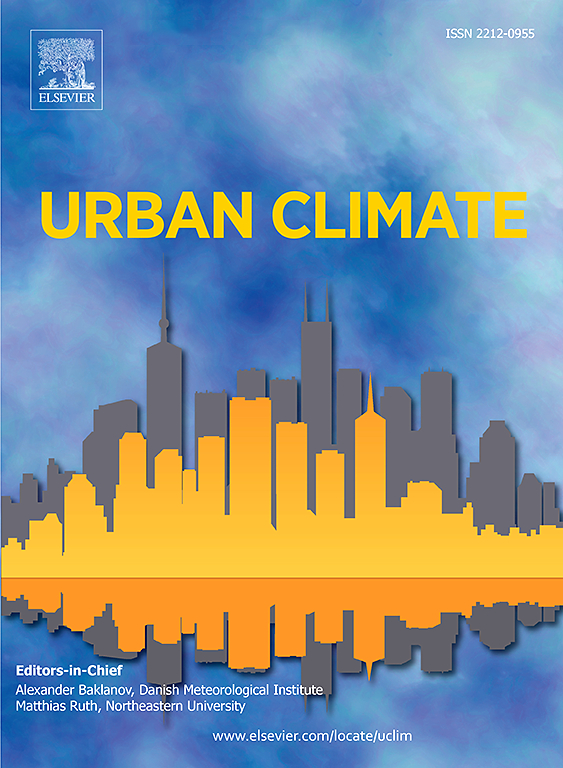Synergistic effects of compound temperature-humidity extremes and urban heat-moisture islands: An observational study in high-density humid subtropical twin cities
IF 6.9
2区 工程技术
Q1 ENVIRONMENTAL SCIENCES
引用次数: 0
Abstract
Research on the synergistic effects of compound temperature-humidity extremes on urban heat island (UHI) and urban moisture island (UMI), particularly in humid subtropical climates, remains limited. This study investigates these synergistic effects in Shenzhen and Hong Kong, two neighboring cities in China's Great-Bay-Area that undergone distinct urbanization processes. Based on the 90th percentiles of daily moving averages of air temperature and specific humidity, three types of extreme events (HotWet, Hot, and Wet events) were identified. Categorical analysis was performed using ten-year observational data across five types of built-up-areas classified by the local climate zones scheme, while spatial analysis drew from 154 weather stations. Results reveal that UHI intensity follows a hierarchy: urban high-rise & urban low/mid-rise areas > urban park & urban seaside > suburban. Extreme events generally intensify UHI and UMI effects, with a stronger impact observed in Shenzhen than in Hong Kong, where UHI and UMI are, on average, 0.22 °C and 0.24 g/kg higher, respectively. Hot events increase UHI by approximately 0.25 °C more than HotWet events, whereas HotWet events enhance UMI by about 0.06 g/kg more than Wet events. Urban vegetation and blue spaces mitigate extreme weather effects, but their effectiveness varies with extreme weather type and urban factors. The frequency of compound extremes is positively correlated with UHI in both summer and winter while positive correlations with UMI intensity are only observed in winter. These findings emphasize the importance of urban resilience enhancements.
复合温湿度极端事件与城市热湿岛的协同效应:高密度亚热带湿润双城的观测研究
关于复合极端温湿度对城市热岛(UHI)和城市湿岛(UMI)的协同效应的研究,特别是在湿润的亚热带气候条件下,仍然有限。本研究以大湾区两个相邻城市深圳和香港为研究对象,探讨了这两个城市的协同效应。根据气温和比湿日移动平均值的第90百分位,确定了三种极端事件(HotWet、Hot和Wet事件)。分类分析采用当地气候带方案划分的5种建成区类型的10年观测数据,空间分析采用154个气象站的数据。结果表明,城市热岛强度具有一定的等级关系:城市高层;城市中低楼层>;城市公园&;城市海滨>;郊区。极端事件通常会加剧UHI和UMI效应,其中深圳的影响强于香港,香港的UHI和UMI平均分别高出0.22°C和0.24 g/kg。热事件使UHI比热湿事件增加约0.25°C,而热湿事件使UMI比湿事件增加约0.06 g/kg。城市植被和蓝色空间可以缓解极端天气的影响,但其效果因极端天气类型和城市因素而异。在夏季和冬季,复合极端事件的频率与UHI呈显著正相关,而与UHI强度呈显著正相关的只有冬季。这些发现强调了增强城市韧性的重要性。
本文章由计算机程序翻译,如有差异,请以英文原文为准。
求助全文
约1分钟内获得全文
求助全文
来源期刊

Urban Climate
Social Sciences-Urban Studies
CiteScore
9.70
自引率
9.40%
发文量
286
期刊介绍:
Urban Climate serves the scientific and decision making communities with the publication of research on theory, science and applications relevant to understanding urban climatic conditions and change in relation to their geography and to demographic, socioeconomic, institutional, technological and environmental dynamics and global change. Targeted towards both disciplinary and interdisciplinary audiences, this journal publishes original research papers, comprehensive review articles, book reviews, and short communications on topics including, but not limited to, the following:
Urban meteorology and climate[...]
Urban environmental pollution[...]
Adaptation to global change[...]
Urban economic and social issues[...]
Research Approaches[...]
 求助内容:
求助内容: 应助结果提醒方式:
应助结果提醒方式:


